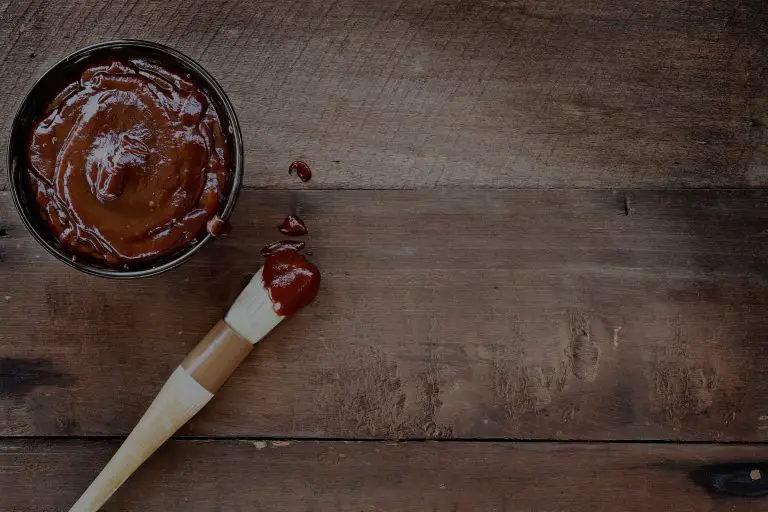If you’ve just started basting your meat and you’re wondering what to do with the mess you’re making of your basting brush, don’t worry. It’s very easy to clean a basting brush and we’re here to show you how it’s done.
Our 5 step process for how to clean a basting brush (simple and easy) means washing it as soon as you’ve finished using it, cleaning it with hot water and detergent, visually inspecting it for any trapped oil or food, rinsing and sanitizing the brush and then allowing it to air dry.
However, if you want to know how to clean a basting brush, you have to understand what a basting brush is and how it is used, what goes into a basting brush (design, handle and bristles) and then you can work out how to clean it (by hand or dishwasher). You might also want to know when cleaning can no longer save your basting brush and it’s time to get a new one. So, let’s see how to do just that.
What Is A Basting Brush And Why Does It Matter How You Clean It?
A basting brush is any kind of brush that you use to apply a sauce, an oil or a glaze to a dish while you’re preparing or cooking food.
It’s worth noting that a basting brush is not an essential item and if you can’t find one – you can always use a substitute. We’ve used everything from leafy greens to coffee filters at some point – you’re just looking for something to move things over a surface when all is said and done.
However, given that basting brushes are much easier to use than most of the alternatives and that they can be bought very cheaply, we’d say that most kitchens are going to own 2 or 3 basting brushes at any given time.
Cleaning these brushes properly matters because if you don’t clean them well, they won’t last as long. We live in an age of increasing environmental awareness, we don’t care for our things just because it saves money but also because it saves the planet.
The materials and design of a basting brush, to some extent, dictate how you can clean it. You’ll be pleased to know that if you elect for a particular option of basting brush – you will be able to clean it in the dishwasher but for others, you may have to clean them by hand.
What’s In A Name? The Basting Brush vs Pastry Brush Argument
You may find it confusing, but a pastry brush and a basting brush are essentially interchangeable terms. Sure, there are vendors out there that would like to have you believe differently because then they can sell you a pastry brush AND a basting brush but they’re not.
They both serve the same purpose – to be dipped in a liquid and then dragged over the outside of what you’re cooking. That might be pastry, mind you, but it also might be roast lamb or roast potatoes or grilled trout. In fact, almost everything that can be cooked can be “basted” in some way.
The 6 Different Designs Of Basting Brushes
There are 6 different designs of pastry/basting brush that you might come across. These don’t tend to affect the way we clean a basting brush dramatically, but you may find that the larger the brush – the more effort you need to put into cleaning it:
- Small basting brush. When you want to do some detailed basting work or have something a little fragile to work on – you probably want a brush with a small surface area.
- Large basting brush. Got a whole hog on the BBQ? Then delicate work is out the window. The bigger brushes are great at handling big tasks.
- Wide basting brush. When you want a very even coat on a large basting job, the wider the brush, the easier it is to ensure that everything is even.
- Round basting brush. These delicate little brushes are designed for very detailed work on pastries and the like. They don’t offer enough surface for bigger tasks.
- Angled basting brushes. If you’ve got to get into nooks and crannies on the cooking surface – this is your best bet.
- Hooked basting brushes. These are simple to hook on to where you’re storing them or on the plates, etc. while you’re working.
What Kinds Of Bristles Are On A Basting Brush?
Bristles are very important on basting brushes and there are four main choices to be made:
- Boar bristles. These are super soft and are really good at absorbing oils and holding a lot of liquid. The downside is they’re harder to clean and they really don’t do well with thick sauces – they tend to very clumpy. If you put them in a dishwasher, they will fall out faster than some of the other bristles.
- Nylon bristles. These are strong and great at handling thick sauces over large surface areas. They tend to be very easy to clean by hand.
- Silicone bristles. The all-purpose bristle that can tackle any job. They’re great in high-heat situations and can be thrown in the dishwasher without a second thought.
- Teflon bristles. These are meant to mimic boar hairs and do a similar job. They’re much more heat resistant than boar hair, mind you and can be placed in a dishwasher without any concerns.
Does The Handle Of Your Basting Brush Matter?
The handles on basting brushes are made of one of two materials plastic or wood. The most important consideration is not, however, the material but the length of the handle. The hotter the thing you will baste, the longer the handle should be to ensure the safety of your hands.
Then you can choose:
- Wooden handles. Not for dishwashing unless you want to replace your basting brushes every few weeks, but they are very comfortable to hold onto and they offer a great level of grip. If you’re basting in front of others where appearances matter – wood is definitely more stylish.
- Plastic handles. No problems with the dishwasher and they’re always easier to clean than wood, even by hand. They tend to be stronger and can deal with the toughest tasks and no matter how gingerly you treat your wooden brushes – plastic will last longer.
How To Clean That Basting Brush (By Hand Or Dishwasher)?
We’ve touched on this already but it’s important to remember that:
- Wooden handles and/or animal hair on a basting brush mean that dishwashing is out of the question. You may find that animal hair is ruined on the first attempt to use a dishwasher and wooden handles will warp and crack in the heat.
- Plastic handles and synthetic hairs are the perfect combination for your dishwasher and the only thing to remember when using the dishwasher is to make certain that they’re kept secure so that they don’t float off and get caught during the washing process.
If you have to wash your basting brush by hand, then we’ve always used this simple 5 step process to get the job done:
- Clean it as soon as you finish using it. If that’s not possible – soak the brush in hot, soapy water while you keep working. This means that oils will work their way out to some extent and those other liquids won’t harden in the bristles.
- Clean with hot water and ordinary washing detergent. It’s best to run the brush under the water and then soap it clean. This helps remove anything stuck to the bristles.
- Inspect the brush visually. Is there anything stuck to the base or the bristles? If so, get it out.
- Rinse the brush with cold or warm water and dip it in a sanitizing solution.
- Let it air dry.
When To Replace Your Basting Brush Because Cleaning Can Only Do So Much
Even the best basting brushes are pretty cheap but it’s fair to say that if you look after them well, you should be able to get years of life out of a plastic brush with synthetic bristles and a wooden one should last a reasonable amount of time too.
The time to replace a basting brush is when you can’t get the oil or sauce out of the hairs anymore or when the hair starts falling out on the food you’re preparing on a regular basis. Because they’re a low cost item, you shouldn’t hesitate to replace them when they’re no longer hygienic.
Conclusion
We think our 5-step process on how to clean a basting brush (simple and easy) is possibly the simplest thing you’ll ever need to learn to do in your kitchen.
It is important, though, keeping your brushes clean will help you save money and save the planet. It will also ensure you don’t get food poisoning from any trapped dirt.
That’s a pretty good return for some hot water and soap, right?
Scot has loved smoking food in his free time for the last few years. Each major holiday or off-weekend, Scot spends days testing and prepping new recipes for perfection.

